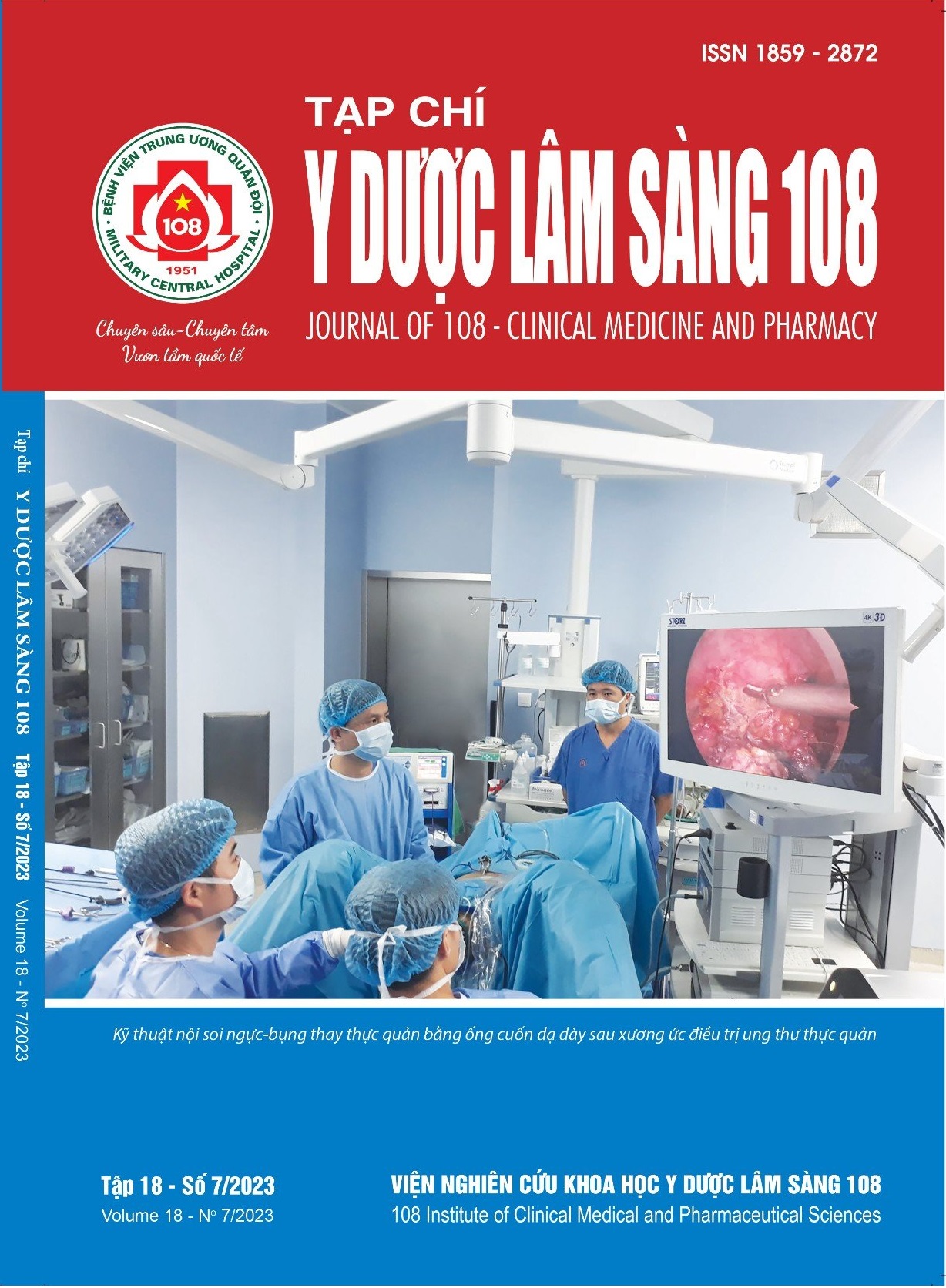Clinical, subclinical characteristics and factors related to post-stroke epilepsy
Main Article Content
Keywords
Abstract
Objective: To describe clinical and paraclinical characteristics and some factors related to late epilepsy of supratentorial stroke. Subject and method: A prospective study of 1061 patients with supratentorial stroke at 108 Military Central Hospital and Phu Tho Provincial General Hospital from 2018 - 2022. Clinical, paraclinical examination and disease monitoring. The patient was discharged from the hospital until January 2023. Result: There were 41/1061 patients with late seizures, of which 40 (97.7%) had motor seizures and 23 (56.1%) patients had generalized seizures. Average age was 63.8 ± 10.9 years old, men accounted for 73.2%. Average Glasgow score 14 ± 1.9, average NIHSS score 6.7 ± 4.8. CT and MRI images recorded 48.8% of damage in the right hemisphere, of which 51.2% had damage to the subcortical areas, most commonly in the parietal lobes. 85.4% were cerebral infarcts and 63.4% were in the blood supply area of the cerebral artery. Video electroencephalograph detected abnormalities in 10/41 (24.4%) cases, mainly sharp waves. The most common lobes were the parietal and temporal lobes, accounting for 9/41 (22%). Factors related to late seizures were advanced age, history of cardiac arrhythmia, history of previous cerebral infarction, and damage to an area of blood supply artery. Conclusion: Late post-stroke epilepsy starts with motor seizures and generalized epilepsy. Related factors include advanced age, history of arrhythmia, and previous ischemic stroke.
Article Details
References
2. Waafi AK, Husna M, Damayanti R & Setijowati N (2023) Clinical risk factors related to post-stroke epilepsy patients in Indonesia: a hospital-based study. The Egyptian Journal of Neurology, Psychiatry and Neurosurgery 59(39).
3. Agarwal A, Sharma J, Padma Srivastava MV, Bhatia R, Singh MB, Gupta A, Pandit AK, Singh R, Rajan R, Dwivedi S, Upadhyay A, Garg A, Vishnu VY (2021) Early post-stroke seizures in acute ischemic stroke: A prospective cohort study. Ann Indian Acad Neurol 24(4): 580-585.
4. Bladin CF, Alexandrov AV, Bellavance A, Bornstein N, Chambers B, Coté R, Lebrun L, Pirisi A, Norris JW (2000) Seizures after stroke: A prospective multicenter study. Archives of neurology 57(11): 1617-1622.
5. Chen TC, Chen YY, Cheng PY, Lai CH (2012) The incidence rate of post-stroke epilepsy: A 5-year follow-up study in Taiwan. Epilepsy research 102(3): 188-194.
6. Galovic M, Döhler N, Erdélyi-Canavese B, Felbecker A, Siebel P, Conrad J, Evers S, Winklehner M, von Oertzen TJ, Haring HP, Serafini A, Gregoraci G, Valente M, Janes F, Gigli GL, Keezer MR, Duncan JS, Sander JW, Koepp MJ, Tettenborn B (2018) Prediction of late seizures after ischaemic stroke with a novel prognostic model (the SeLECT score): A multivariable prediction model development and validation study. The Lancet Neurology 17(2): 143-152.
7. Graham NS, Crichton S, Koutroumanidis M, Wolfe CD, Rudd AG (2013) Incidence and associations of poststroke epilepsy: The prospective South London Stroke Register. Stroke 44(3): 605-611.
8. Guo X, Zhong R, Han Y, Zhang H, Zhang X, Lin W (2022) Incidence and relevant factors for seizures after spontaneous intracerebral hemorrhage: A systematic review and meta-analysis. Seizure 101: 30-38.
9. Gupta SR, Naheedy MH, Elias D, Rubino FA (1988) Postinfarction seizures. A clinical study. Stroke 19(12): 1477-1481.
10. Kammersgaard LP, Olsen TS (2005) Poststroke epilepsy in the Copenhagen stroke study: Incidence and predictors. Journal of Stroke and Cerebrovascular Diseases 14(5): 210-214.
11. Lahti AM, Saloheimo P, Huhtakangas J, Salminen H, Juvela S, Bode MK, Hillbom M, Tetri S (2017) Poststroke epilepsy in long-term survivors of primary intracerebral hemorrhage. Neurology 88(23): 2169-2175.
12. Ozon AO, Cüce F (2020) Clinical and radiological evaluation of epilepsy after ischemic cerebrovascular disease. Gulhane Med J 62:126-130.
13. Phan J, Ramos M, Soares T, Parmar MS (2022) Poststroke Seizure and Epilepsy: A review of incidence, risk factors, diagnosis, pathophysiology, and pharmacological therapies. Oxid Med Cell Longev: 7692215.
14. Sivaci A (2015) Correlation between lesion location and EEG findings in post-stroke epilepsy. EPILEPSI 21(1).
15. Wang G, Jia H, Chen C, Lang S, Liu X, Xia C, Sun Y, Zhang J (2013) Analysis of risk factors for first seizure after stroke in Chinese patients. BioMed research international.
16. Zou S, Wu X, Zhu B, Yu J, Yang B, Shi J (2015) The pooled incidence of post-stroke s eizure in 102 008 patients. Topics in stroke rehabilitation 22(6): 460-467.
 ISSN: 1859 - 2872
ISSN: 1859 - 2872
